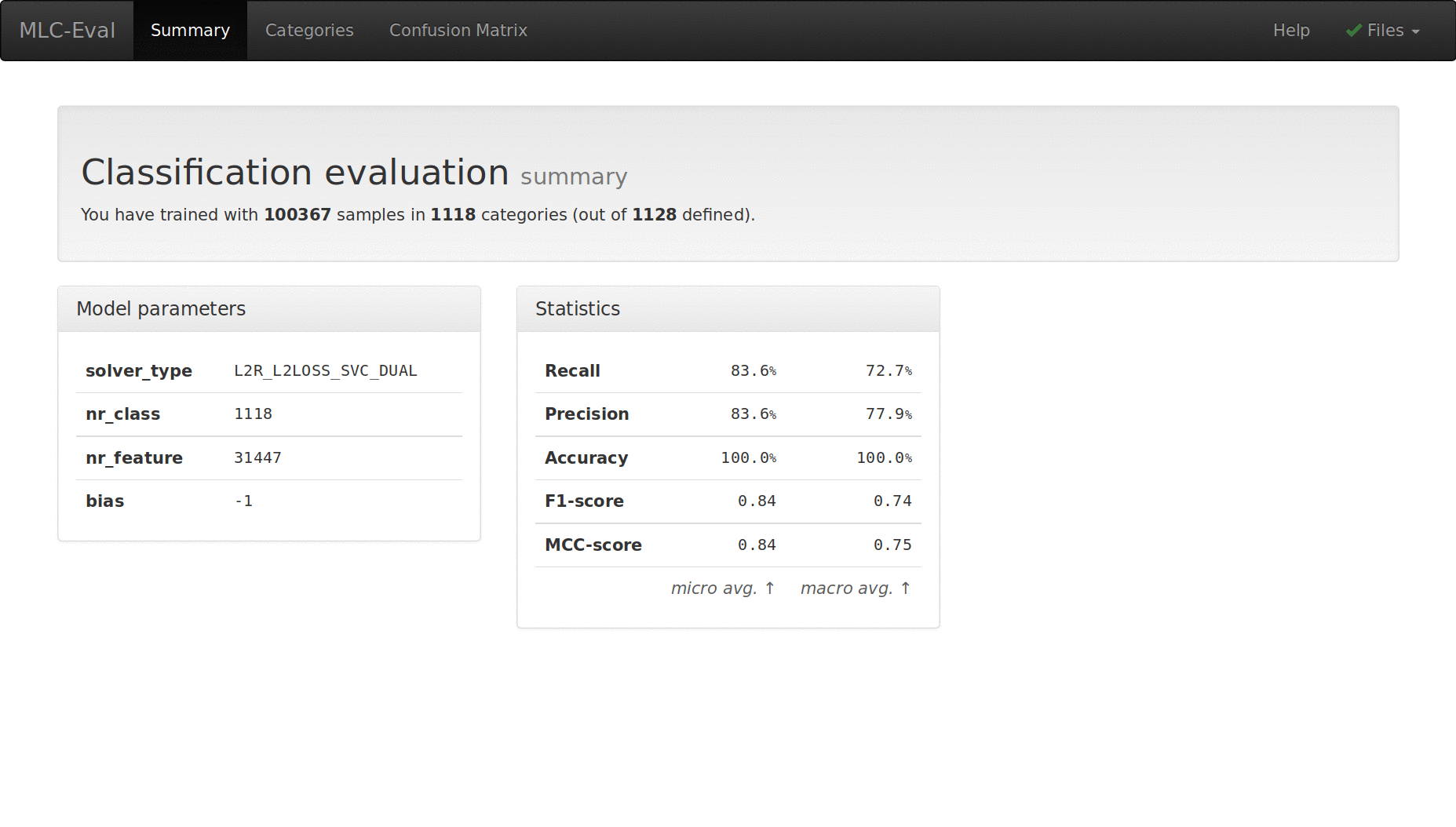A user-interface for evaluation of classification results.
When working with classification in machine learning, evaluation of results can be very useful to check and improve. For larger datasets, existing tools remain limited. This project provides a web-based user-interface for looking into classification results, which should also work with thousands of classes.
The initial focus was on LIBSVM and LIBLINEAR, which provide a convenient way to work with support vector machines on large datasets, but other software and methods are also supported (as long as the relevant files are generated).
Visit the online app directly.
This project isn't fully complete in the sense that there's more useful information to show. But it provides a starting point with a summary, category overview and Confusion matrix.
By default, the widely used iris dataset will be shown. It isn't a very good example to showcase
this tool, with just three classes. To load your own dataset, put your own data.cm and other files
in public/data/, and add ?baseUrl=/data/data to the url.
If you want to view data behind the training features in data.features, you can use the first
column in that file to indicate an id. Supply a query parameter itemUrlTemplate=http://.../:id
to this web application, and the Categories view will show a link in the Training features
pane. You can use this to improve your training data, for example.
The easiest way would be to visit the hosted app directly.
To run this tool yourself, you'll need Node.js to run the web application. For generating the confusion matrix for LIBSVM/LIBLINEAR (see below), you need Ruby.
To run the web application yourself:
$ npm install
$ npm start
A web browser window will open on http://localhost:3000/ .
Classification data is read from the following files, currently served from public/data/:
data.cm- confusion matrixdata.labels- label names, to show class names instead of numbers (optional but recommended)data.model- the trained model, only the header is read to show properties (optional)data.features- training data features, for showing data behind trained classes (optional)
These files need to be created by your classification software. LIBSVM generates data.model,
a tool for generating the confusion matrix is part of this project (see below). See file formats
below for an explanation (as well as the example in public/example).
A confusion matrix can be generated after doing cross-validation on the training data.
This can be done with the supplied scripts libsvm-cm.rb or liblinear-cm.rb (you'll need Ruby).
Options are the same as for svm-train or liblinear-train.
$ gem install rb-libsvm
$ ruby libsvm-cm.rb public/example/data.train public/example/data.cm
or
$ gem install liblinear-ruby
$ ruby liblinear-cm.rb public/example/data.train public/example/data.cm
For reference, the confusion matrix file used here has the following format. Consider four
classes, 1, 2, 3 and 4, with 6 training items each. Predictions are on the x-axis,
actual classes are on the y-axis. First line and first column are headers.
Sums for each line and column are at right and bottom.
- 1 2 3 4 +
1 5 0 0 1 6
2 1 4 1 0 6
3 0 0 4 2 6
4 1 0 2 3 6
+ 7 4 7 6 24
Consists of class labels in numeric format and their human-readable representation.
1 Setosa
2 Versicolour
3 Virginica
The header of this file consists of parameters, which are shown as summary. A line
containing SV indicates the last line. A LIBSVM model file follows this format,
but other software could generate this (without model data) to show parameters.
Each line of this file contains a training item, with an item id, true class and the predicted class; the remainder of the line is a text-representation of the item's features.
For example, the following line is for a training item with id 1337, has class
number 5, the predicted class is 6, and the features are guide and galaxy
1337 5 6 guide galaxy
In this case, the algorithm is likely using a bag of words, so it makes sense to just list the words extracted from the training source data. This is likely to be different for other classification problems.
The id is there to link to the source data, so that you can see where feature extraction
may need to be improved. The placeholder :id in the itemUrlTemplate query parameter
will be substituted by this number for each item in the Categories view.
- include example data
- allow loading of remote urls
- allow browsing and loading of local files
- add more metrics, also for each class
